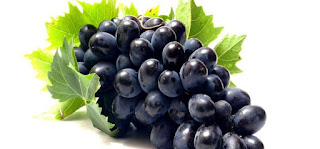Muscat of Hamburg (also known as Golden Hamburg, Black Hamburg, and Muscat de Hamburg, among 100 other synonyms) is the weakest of the muscats, in terms of aromas and flavor profile, and its origins are somewhat murky, but that has not prevented this black-skinned variety from gaining traction around the world as both a table and a wine grape.
The characteristics of the cultivar are as follows:
- Vine
- High-yielding
- Bunches
- Medium-to-large
- Conical
- Well-filled
- Berries
- Blue-black
- Medium-to-large
- Oval shaped
- Shiny
- Seeded
- Firm skin
- Soft and juicy pulp with strong muscat flavor
- Sweet
- Medium-ripening
- Wines
- Ruby colored
- Low alcohol.
 |
| Muscat of Hamburg |
DNA analysis has shown that the variety is the result of a cross between Schiava Grossa (Trollinger) and Muscat of Alexandria. One origin story has the crossing as the handiwork of one R. Snow who operated greenhouses in Bedfordshire, England in the mid-1800s. An alternative history has the crossing occurring in Hamburg (Germany) with the variety cultivated therein from the mid-1830s and from whence it made its way to England around 1850. In England, large quantities were grown in greenhouses by Snow and a colleague named Venn. England was the launch point for the crossing's journey around the world.
In France, Muscat of Hamburg is used both as a table grape and a wine grape. In the Vaucluse department (southern Rhone) there is a table grape AOC called Muscat du Ventoux. There are a total of 2325 ha of the vines planted in the country.
In Eastern Europe, the crossing is used to make light, dry red wines. Two hundred and fifty-four ha of vines are planted in Moldova, 350 in North Macedonia, 624 ha in Serbia, 180 ha in Russia, and 12 ha in Hungary.
In Germany the wine grape is called Muscat-Trollinger and its cultivation can be traced all the way back to 1850. A total of 113 ha is planted of which 109 can be found in the Würtemberg area. Other European countries have distributions as follows: Italy, 22 ha; Greece, 2288 ha; Spain, 125 ha; and Switzerland, 0.1 ha.
China and Japan use the grape for table wine blends while the USA (113 ha, primarily in CA but with representation from VA, OR, TX, NY (Ice wine), and Washington), Canada (Vancouver Island), Uruguay (1267 ha), and Australia (35 ha) round out the "New World" contribution.
Muscat of Hamburg shows deeply colored skin but that color does not transfer to wines made from the grapes. Wines are generally a light blush or rosé style lacking in both acidity and character. Some dessert wines have been made from overripe grapes while some producers have used long hang time to tease out a more aromatic wine.
Muscat of Hamburg grapes have been used in some Greek PGI wines and I will explore those in future posts.
No comments:
Post a Comment